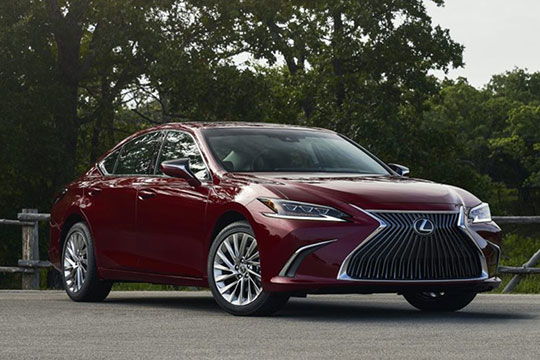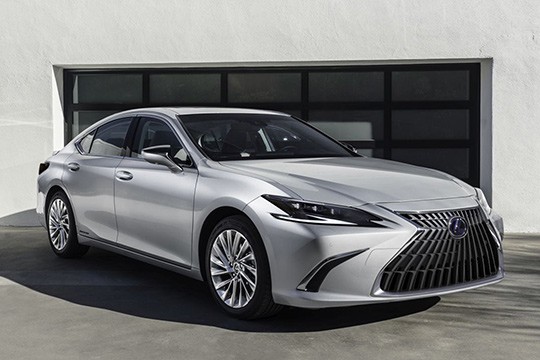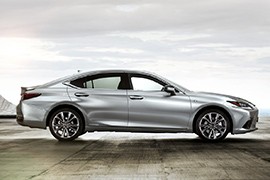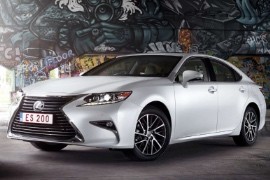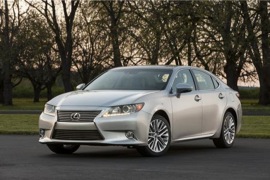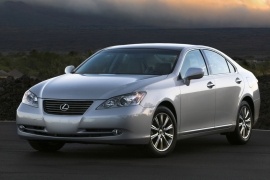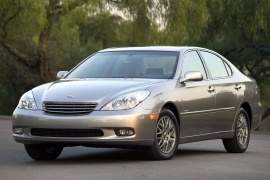LEXUS ES Models/Series Timeline, Specifications & Photos
First production year: 2002
Engines: Gasoline, Hybrid gasoline, Hybrid
Lexus refreshed its best-selling model, the ES, in 2023 for the 2024 model year, and, along with some new wheels and minor exterior updates, it also drastically improved the interior and drivetrain.
The ES shared its platform with the Camry and the Avalon. In 2018, the Japanese premium automaker introduced the seventh generation of the ES, and even though it shared its underpinnings with the other two sedans from Toyota, it came with different settings that made it feel sportier. In addition, the standard 18" light-alloy wheels for the base trim level and the 19" ones for the upper ones gave the car a distinct, sporty look. In addition, for the 2024 model year, the ES offered standard Bi-LED headlamps.
But the most significant change was inside the vehicle, where Lexus improved the cabin after it listened to its customers. It took too many years for the automaker to understand that the touchpad was a pain for most users and was mostly useless while driving. By removing it, it cleared the area and made room for a pair of cup holders for both front occupants. At the lower side of the center stack, the automaker placed the HVAC controls, including those for the heated steering wheel and the cooled and warmed seats. Above it, Lexus placed the sound system that was also available with a 17 speakers Mark Levinson option. Furthermore, the infotainment unit featured a 12.3" touchscreen placed atop the center stack and provided wireless Apple CarPlay and Android Auto. Fortunately, the Japanese premium automaker kept the turning knob for the volume, even though it ditched the CD player from the sound system.
The driver could enjoy the digital dashboard and also the head-up display. In addition, Lexus tried to pamper its users and offered an option for wood trims on the steering wheel. Thanks to the vehicle's long wheelbase, the automaker could provide enough legroom for passengers seated in the back. Thus, the ES proved to be not just an excellent executive vehicle but also a great family car.
Lexus offered the 2024 ES with a choice of gasoline engines. The base model offered a decent, fuel-efficient 2.5-liter inline-four that sent the power in all corners via an electronically controlled AWD system. The most powerful version offered customers a 3.5-liter V6 which sent all of its ponies exclusively to the front wheels via an eight-speed automatic gearbox. For those looking for an electrified vehicle, Lexus offered the choice of a 2.5-liter inline-four unit that ran in the Atkinson cycle and was helped by a high-density electric motor. Unfortunately, due to the li-ion battery pack placed under the rear seats, this version was available with just a front-wheel drive option. But it was an excellent choice for those living in areas where snow never comes.
Lexus refreshed the seventh generation of the ES range and unveiled it at the 2021 Auto Shanghai, showing fewer exterior changes but more upgrades for the interior and driving dynamics.
Ever since its first generation, Lexus tried to catch more customers from Acura's buyers. To convince them, it tried to offer better technologies and more luxurious features. But the carmaker was also obsessed with quality control, and it topped the ranks for the most reliable brand in the world several times. But some of the ES features were outdated, and Lexus tried to fix that with the 2021 model year.
On the outside, there were not too many changes. The front fascia still retained a similar spindle design for the grille but with horizontal slats in the background instead of a mesh design. On the sides of its apron, the designers installed smaller side scoops than on its predecessor. Its angular headlights swept-back featured horizontal V-shaped LEDs for the daytime running lights.
Inside, the Lexus finally introduced a touch-screen for the infotainment system, but it didn't give up to the touch-pad from the center console. To make the new, standard 8" displays easier to reach, it moved it forward 4.3 inches (11 cm). A 12.3" unit was on the options list. The carmaker also added rear-view cameras instead of mirrors, with the screens mounted a the bottom of the A-pillars.
Under the hood, Lexus kept the same engines as its non-facelifted version. The F Sport trim level added the ES 300h S SPORT variant for selected markets.
Lexus has always made luxurious cars and the ES was no exception. It offered comfort, style, elegance and softness for the pickiest drivers.
And when I say picky, I am only referring to those who were looking for comfort, because the ES offered little to no sportiness and not much feedback to feel in touch with the car.
The ES reached its 6th generation in 2018, a model that was based on the Camry.
The ES had an electric trunk that could only be opened using the key, however, the good part about it was that the load area held enough items. Plus, it was equipped with bags for shopping.
Even if the ES was not considered a fast car, it was equipped with a 3.5-liter V6 engine, developing 268 hp, mated with a 6-speed automatic transmission. The engine was incredibly quiet and vibration free and the transmission did its job so well you could not feel the gear shifting.
The interior of the ES is what we call luxurious. While it did not have many gadgets, unlike the german cars, the clean look of the ES offered features any driver would appreciate.
The steering wheel had a nice wood and leather combination, as well as the door panels that were wrapped up in leather, with the exception of the trims which were piano black. The dash was covered in nice looking simulated leather.
The front seats were both ventilated and heated, as well as the steering wheel.
What was unusual was the way the driver could control the infotainment system. The ES had something similar to a computer mouse, with an “enter” button on the left side. Luckily, most of the controls were duplicated in the buttons.
Lexus introduced the sixth generation of the ES in 2012, and four years later, it came with an update for the mid-size sedan.
Based on the same Toyota K platform as the Camry and the Avalon, the ES tried to offer a premium experience for its customers. In many ways, it succeeded and offered not only a more comfortable and luxurious ambiance inside but also a more than decent performance.
With the updated version, the carmaker emphasized the spindle-grille theme design that was noticed on other Lexus models from that era. The aggressive look was completed by the angular shapes of the headlights, which looked like they were attacking the road ahead. Moreover, the lower side scoops from the bumper sported the foglights and the chromed trims inside.
Inside, the luxurious cabin was one of the best in its class. Thanks to the front-wheel drive platform combined with the long wheelbase, the carmaker could provide enough legroom for five passengers. Even the one sitting in the middle on the rear bench sat comfortably. The dashboard offered an integrated infotainment screen placed on top and was surrounded by top-quality materials. For the instrument cluster, Lexus kept the analog dials, albeit it still featured a small TFT display between the tachometer and speedometer.
Under the hood, Lexus offered a choice of gasoline or hybrid drivetrains. The former was paired to a six-speed automatic while the latter was mated to an eCVT (electronically controlled variable transmission).
Lexus introduced the ES model in 1989, and by 2012 it rushed through new models, facelifts, and improvements, reaching its sixth generation.
It was launched at the 2012 New York Motor Show, and its letters symbolized "Executive Sedan," even though some Lexus dealers chose to communicate that it stood for "Elegance Sedan." Either way, both definitions were good. For the sixth-generation ES, the Japanese premium brand added more engine options and, obviously, a hybrid drivetrain to provide better fuel efficiency.
Based on the same platform as the Toyota Camry, the ES featured the spindle grille at the front with its swept-back headlights towards the front fenders and corner-mounted turn signals. In the lower bumper, the apron was flanked on the sides by round fog lights, which contradicted the car's sharp-angles styling. Its profile revealed a slight upward kink at the rear doors, just in front of the C-pillars. Finally, at the back, the ES featured wide taillights spread on the rear quarter panels and on the trunk lid.
Like any Lexus, the ES offered a nice interior garnished with expensive materials and excellent fittings. The dashboard focused on the driver with a small instrument cluster that featured two large dials for the speedometer and tachometer, flanked by the coolant temperature gauge on the left and the fuel level on the right. Lexus installed the screen for the infotainment unit atop the center stack into the dashboard. It was controlled via a controller placed on the center console. The cabin was good for up to five occupants, with two bucket seats at the front and a bench in the rear.
Under the hood, Lexus installed a wide engine choice, all gasoline-powered, ranging from 184 hp to 268 hp. The hybrid version featured a 2.5-liter inline-four Atkinson-cycle powerplant and an electric motor.
Based on the same platform with the best-seller Toyota Camry, the 2007 Lexus ES was launched in February 2006 at the Chicago Auto Show.
The ES was considered for a long time their entry-level model. It wasn't as sophisticated a hybrid or a high-performance vehicle. It was just another Camry with better materials and nicer design. The ES was one of the quickest cars to 60 mph (97 kph) with a front-wheel-drive and it was timed with 6.2 seconds.
The exterior look showed the new headlights design for the brand's image. The small grille was flush to the hood, on the same arch. It was different than other Lexus vehicles on the market that showed a more vertical grille. The sloped rear end helped the car achieve a better drag-coefficient.
Inside, the Lexus ES 350 interior featured walnut wood accents, leather seats, dual-zone climate control with air filter, an MP3 player auxiliary input, power tilt, and telescoping steering wheel, and eight standard airbags. A keyless entry and ignition system, Lexus SmartAccess, which does not require the electronic remote to be taken out of the driver's pocket, was standard.
Under the hood, there was a new, 3.5-liter V6 engine. It was the same unit that was later on found on some other Toyota models all-over the world. It was mated to a 6-speed automatic transmission and helped to gain traction with an intelligent traction control unit.
Lexus started the production for the ES fourth-generation n 2001 in Japan and built it exclusively there on the Toyota K platform shared with the Camry and the Avalon.
By 2001, Lexus was already known for its high-quality, very dependable vehicles. The ES range appeared on the market in 1988 as a rebadged Toyota Camry Vista and rushed through generations building three of them in just 13 years. The fourth generation of the ES received features from the company's flagship, the LS, and rfined technologies such as the drive-by-wire electronic throttle.e
Thanks to its fluid lines and raked front fascia and windshield, the 2002 ES obtained a Cx 0.28, increasing the car's fuel efficiency. Its swept-back headlights and slanted grille created a dynamic image for the luxurious four-door sedan. On its sides, the chromed door handles and trim around the window line amplified the premium image.
Inside, Lexus installed a carefully crafted interior with California walnut trim on the steering wheel, dashboard, center stack, and doors. It was finished to one of the greatest attention in its segment and adorned with chromed accents. As an option, the carmaker added a Mark Levinson premium auto, dual-zone climate control, and heated seats. There was plenty of room for all passengers, and the bench could comfortably host three people in the back.
Under the hood, Toyota installed a 3.0-liter engine paired with a five-speed automatic gearbox. It used the same drivetrain from the Camry, hence the front-wheel-drive system. Starting with 2006, the car received a 3.3-liter version as well.
